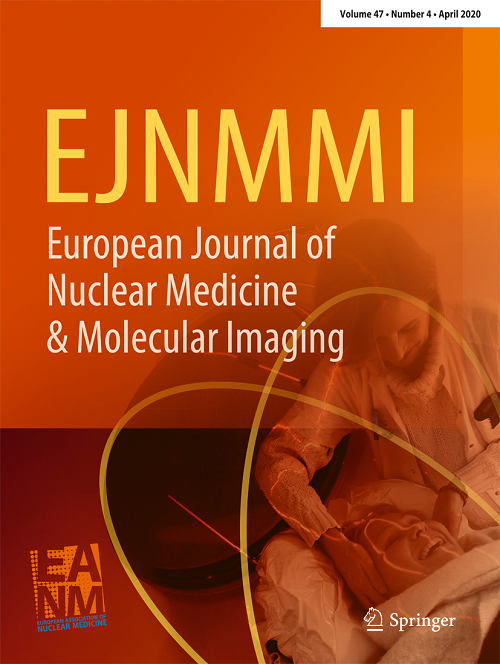[18F]肾上腺髓质和肾上腺外副神经节转移性肿瘤的SiTATE PET筛选和监测。
IF 7.6
1区 医学
Q1 RADIOLOGY, NUCLEAR MEDICINE & MEDICAL IMAGING
European Journal of Nuclear Medicine and Molecular Imaging
Pub Date : 2025-09-19
DOI:10.1007/s00259-025-07550-2
引用次数: 0
摘要
目的:在生长抑素受体(SSTR)表达的肿瘤中,SSTR定向成像和治疗在疾病控制方面显示出良好的效果。本研究评估了[18F]SiTATE在嗜铬细胞瘤和副神经节瘤(PPGL)患者中的PET成像应用,重点关注肽放射受体治疗(PRRT)的资格和治疗监测。方法5例转移性副神经节瘤(n = 3)或嗜铬细胞瘤(n = 2)。[18F]SiTATE应用Krenning评分和基线SUVmax评估PRRT的资格。通过RECIST 1.1标准、肿瘤总体积(基于pet的TTV)和嗜铬粒蛋白A (CgA)分析治疗反应。结果基线时,所有患者均表现出高病变摄取,其中骨摄取最高(平均SUVmax为41.4±87.3),Krenning评分为3-4,提示适合PRRT。在PRRT完成后2.5个月的随访中,所有患者病情稳定(RECIST 1.1), CgA水平下降或稳定,而3例患者的TTV升高,因此表现出异质性反应。结论:在转移性PPGL中,[18F]SiTATE可有效显示肿瘤负荷,支持PRRT的患者选择和疗效评估。值得注意的是,数据显示了基于pet、ct和生化评估的异质性反应。这些差异的潜在机制尚不清楚,需要进一步调查。本文章由计算机程序翻译,如有差异,请以英文原文为准。
[18F]SiTATE PET for PRRT selection and monitoring metastatic tumors of the adrenal medulla and extra-adrenal paraganglia.
PURPOSE
In somatostatin receptor (SSTR)-expressing tumors, theranostics with SSTR-directed imaging and therapy showed promising results regarding disease control. This study evaluated the use of PET imaging with [18F]SiTATE in pheochromocytoma and paraganglioma (PPGL) patients, focusing on eligibility for peptide radioreceptor therapy (PRRT) and therapy monitoring.
METHODS
Five patients with metastatic paraganglioma (n = 3) or pheochromocytoma (n = 2) were included. Eligibility for PRRT was assessed by [18F]SiTATE applying the Krenning score and baseline SUVmax. Treatment response was analyzed by RECIST 1.1 criteria, total tumor volume (PET-based TTV), and Chromogranin A (CgA).
RESULTS
At baseline, all patients showed high lesional uptake, with the highest in the bone (mean SUVmax 41.4 ± 87.3) and a high Krenning Score of 3-4, Suggestive for PRRT eligibility. At the follow up, 2.5 months after completion of PRRT, all patients presented with stable disease (RECIST 1.1) and decreasing or stable CgA levels, whereas TTV increased in three patients and thus showed heterogenous response.
CONCLUSION
In metastatic PPGL, [18F]SiTATE effectively visualizes tumor burden and supports patient selection and response assessment for PRRT. Notably, the data revealed a heterogenous response across PET-based, CT-based, and biochemical assessments. The underlying mechanisms of these discrepancies remain unclear and warrant further investigation.
求助全文
通过发布文献求助,成功后即可免费获取论文全文。
去求助
来源期刊
CiteScore
15.60
自引率
9.90%
发文量
392
审稿时长
3 months
期刊介绍:
The European Journal of Nuclear Medicine and Molecular Imaging serves as a platform for the exchange of clinical and scientific information within nuclear medicine and related professions. It welcomes international submissions from professionals involved in the functional, metabolic, and molecular investigation of diseases. The journal's coverage spans physics, dosimetry, radiation biology, radiochemistry, and pharmacy, providing high-quality peer review by experts in the field. Known for highly cited and downloaded articles, it ensures global visibility for research work and is part of the EJNMMI journal family.

 求助内容:
求助内容: 应助结果提醒方式:
应助结果提醒方式:


